Divine Shepherdess
Divine Shepherdess
– Answered by Father Johann Roten, S.M.
Q: Is there such a Marian title as the "Divine Shepherdess"?
A: You are probably referring to La Divine Bergère, also called Notre Dame de Brebières. Brebières, designating a pasture, is part of a small town in Picardie (France) named Albert, formerly Ancre, in the diocese of Amiens. The name of the locality, Brebières, makes allusion to brebis, French for sheep, and berger, French for shepherd.
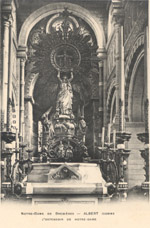
According to tradition, sheep were grazing at Brebières when the shepherd noticed that his herd was concentrating on the same spot for the longest time, biting down on the grass and pulling it up with the roots. The shepherd's curiosity was kindled, and he started digging. Hidden in the ground he found a statue of Our Lady which was sculpted in a piece of flinty yellowish rock.
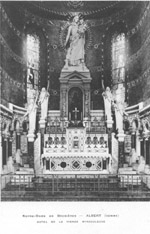
The sculpture, of Romanesque style and 1.20 meters tall, represented Mother and Child with a sheep resting at Mary's feet. As in so many other places, the discovery of the statue (hidden probably to avoid destruction by invading armies) elicited both the curiosity and devotion of the local people and those of the surrounding areas. A small chapel was built on the premises to house the statue and receive pilgrims. These events seem to have occurred at the beginning of the twelfth century. Saint Colette contributed greatly to spread the name and reputation of Brebières. Of modest stature and delicate health, Saint Colette prayed to Our Lady of Brebières and not only obtained strength and courage from her Son but, as goes the legend, several inches were miraculously added to the body of the fourteen-year-old girl.
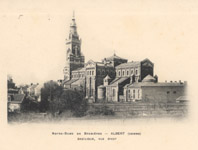
A confraternity was founded in honor of Our Lady of Brebières. Its members were shepherds. The sanctuary played an important role during the time of the Reformation. It was at Brebières that the Marquis of Humières made the decision to launch and promote the Catholic League. In 1637, the town of Albert was ransacked by the Spaniards, and the sanctuary was partially burned down. This and some other reasons led to the decision to move the miraculous image to the parish church of Albert in 1727. A new confraternity was founded, and the pilgrimages to Our Lady of Bresbières resumed. The manifestations of public devotion came again to a brusque standstill during the French Revolution, when the church of Albert became the pagan temple of Goddess Reason. The statue was rescued and hidden in a casket by Mr. Scribe-Poly, only to recover its proper place in the parish church in 1802.
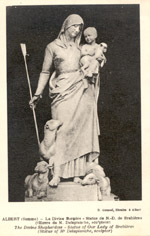
The humble parish church gave way to a beautiful basilica (1883-1887). In 1887 the bishop of Amiens blessed a new statue of Our Lady of Brebières by artist sculptor M. Delaplanche. It tops the high altar and represents Mary as the shepherdess dressed in local garb, holding a staff in one hand and baby Jesus on the other. The child holds a lamb in his arms, and there are four sheep at the feet of mother and child. The patronal feast of Our Lady of Brebières is celebrated on September 8.
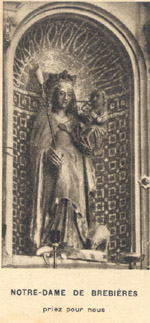
The title “Divine Shepherdess” may be somewhat ambiguous. It should not lead us to attribute a goddess-like status to Mary. Mary, as mother, is the guardian of the Divine Shepherd, Jesus Christ. This is why the title "Divine Shepherdess" should be read as Shepherdess of the Divine Shepherd. The same title is well known in several Latin American countries, where she is known as the "Divina Pastora."
All About Mary includes a variety of content, much of which reflects the expertise, interpretations and opinions of the individual authors and not necessarily of the Marian Library or the University of Dayton. Please share feedback or suggestions with marianlibrary@udayton.edu.
